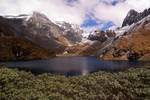For the duration of the trek we experienced perfect weather. Never missed a vista due to clouds or haze. Five snowy nights at altitude. Twenty-five glorious mornings of waking to the beauty of the Bhutanese Himalayas. Cliff took the photo in this blog entry (along with some 2,300 others). There are so many winners in his portfolio that it's difficult to select "just a few" to share with friends and family -- and even his most impressive shots cannot do justice to the landscape and experience of the Snowman Trek.
Is the Snowman the "world's most difficult trek"? Having so many yet to be tried, I'll decline to address that exact question. On a personal note I will observe that it is the most challenging in our experience (terrain + altitude + daily distances + duration). Eleven of the twelve in our group completed the trek. We understand that fewer than one hundred trekkers will attempt the Snowman this year. Our training and preparation absolutely paid off -- we never experienced a sore muscle, although we were quite spent at the end of most every day.
The experience -- 24 days, 216 miles, 11 passes (6 over 16,000 feet) all in a single pair of hiking trousers (no joke!). No connectivity, media, motorized vehicles (yak and horse poop replaced fossil fuel emissions), electricity or plumbing. Would we do it again? No, too much world to see. Would we do it (if we hadn't yet) knowing what we know now? Absolutely! We can say with great certainty that blossom rain does fall in the mountains of Bhutan -- and so does Blossom snow!
Staying present was a practice of great patience and grounding. There were times when noticing the shadows of alpine fern on the path was fulfilling -- and there were times for mantras, music (had my iPod nano) and even counting to even the breath and engage (or calm) the brain at 16,000 feet. And I was thankful at every turn for the desire, ability and resolve to eat, sleep, walk (as we came to know it).
Am I already charting a path to my next adventure/challenge? You bet! There's ample evidence that people who set goals live longer -- and I have a whole lot more living to do. How about you? What's next on your "Do" list?
Am I already charting a path to my next adventure/challenge? You bet! There's ample evidence that people who set goals live longer -- and I have a whole lot more living to do. How about you? What's next on your "Do" list?
Check back in soon as I am resuming the "Art of Doing Stuff" blog this month. I'll be talking about how to turn New Year's Resolutions from dreams into visions -- with goals and a pathway to attainment.
Namaste.







